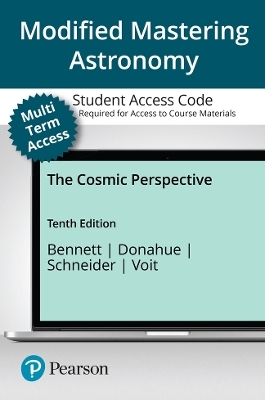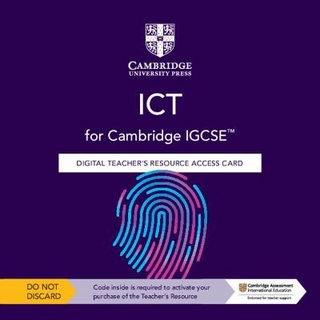
Mastering Astronomy with Pearson eText Access Code for Cosmic Perspective, The
Pearson (Hersteller)
978-0-13-808171-3 (ISBN)
- Titel nicht im Sortiment
- Artikel merken
The 10th Edition provides new discussion of the center of the Milky Way Galaxy, recent research on supermassive black holes, and developments in the search for life beyond Earth. This edition also features new images and insights from modern telescopes, including the James Webb Space Telescope.
Personalize learning with Mastering Astronomy with Pearson+ eTextbook This flexible digital platform combines unrivaled content, online assessments and customizable features to personalize learning and improve results.
Pearson+ eTextbook is an easy-to-use digital textbook available within Mastering® that lets you read, highlight and take notes, all in one place.
NOTE: Before purchasing, check with your instructor to confirm the correct ISBN. Several versions of the MyLab® and Mastering® platforms exist for each title, and registrations are not transferable. To register for and use Mastering, you will need either a course ID from your instructor or an invitation link that your instructor will send you directly.
Used books, rentals, and purchases made outside of Pearson If purchasing or renting from companies other than Pearson, the access codes for the Mastering platform may not be included, may be incorrect, or may be previously redeemed. Check with the seller before completing your purchase.
About our authors Jeffrey Bennett, a recipient of the American Institute of Physics Science Communication Award, holds a B.A. in biophysics (UC San Diego), and an M.S. and Ph.D. in astrophysics (University of Colorado). He specializes in science and math education and has taught at every level from preschool through graduate school. Career highlights including serving 2 years as a visiting senior scientist at NASA headquarters, where he developed programs to build stronger links between research and education; proposing and helping to develop the Voyage scale model solar system on the National Mall (Washington, D.C.); creating the free app Totality by Big Kid Science, designed to help the public prepare for and understand solar eclipses; and creating a free online digital textbook for middle school Earth and space science. He is the lead author of textbooks in astronomy, astrobiology, mathematics, and statistics; of critically acclaimed books for the general public on topics including global warming, Einstein's theory of relativity, the search for extraterrestrial life, and math and science teaching; and of seven children's science books, all of which have been selected for the Story Time From Space program, in which astronauts aboard the International Space Station read books to the children of Earth (with videos posted at storytimefromspace.com). His personal website is www.jeffreybennett.com and his educational websites include www.BigKidScience.com, grade8science. com, and www.globalwarmingprimer.com. Megan Donahue is a full professor in the Department of Physics and Astronomy at Michigan State University (MSU), a Fellow of the American Physical Society and of the American Association for the Advancement of Science, and has been President of the American Astronomical Society (2018–2020). Her research focuses on using x-ray, UV, infrared, and visible light to study galaxies and clusters of galaxies: their contents—dark matter, hot gas, galaxies, active galactic nuclei—and what they reveal about the contents of the universe and how galaxies form and evolve. She grew up on a farm in Nebraska and received an S.B. in physics from MIT, where she began her research career as an x-ray astronomer. She has a Ph.D. in astrophysics from the University of Colorado. Her Ph.D. thesis on theory and optical observations of intergalactic and intracluster gas won the 1993 Robert Trumpler Award from the Astronomical Society for the Pacific for an outstanding astrophysics doctoral dissertation in North America. She continued postdoctoral research as a Carnegie Fellow at Carnegie Observatories in Pasadena, California, and later as an STScI Institute Fellow at Space Telescope. Megan was a staff astronomer at the Space Telescope Science Institute until 2003, when she joined the MSU faculty. She is also actively involved in advising national and international astronomical facilities and NASA, including planning future NASA missions. Megan is married to Mark Voit, and they collaborate on many projects, including this textbook, over 70 peer-reviewed astrophysics papers, and the nurturing of their children, Michaela, Sebastian, and Angela. Megan has run three full marathons, including Boston. These days she runs trails with friends, orienteers, and plays piano and bass guitar for fun and no profit. Nicholas Schneider is a full professor in the Department of Astrophysical and Planetary Sciences at the University of Colorado and a researcher in the Laboratory for Atmospheric and Space Physics. He received his B.A. in physics and astronomy from Dartmouth College in 1979 and his Ph.D. in planetary science from the University of Arizona in 1988. His research interests include planetary atmospheres and planetary astronomy. One research focus is the odd case of Jupiter's moon Io. Another is the mystery of Mars's lost atmosphere, which he is helping to answer by leading the Imaging UV Spectrograph team on NASA's MAVEN mission now orbiting Mars. Nick enjoys teaching at all levels and is active in efforts to improve undergraduate astronomy education. Over his career he has received the National Science Foundation's Presidential Young Investigator Award, NASA's Exceptional Scientific Achievement Medal, and the Richard H. Emmons Award for Excellence in College Teaching. Off the job, Nick enjoys exploring the outdoors with his family and figuring out how things work. Mark Voit is a full professor in the Department of Physics and Astronomy and served as Associate Dean for Undergraduate Studies at Michigan State University. He earned his A.B. in astrophysical sciences at Princeton University and his Ph.D. in astrophysics at the University of Colorado in 1990. He continued his studies at the California Institute of Technology, where he was a research fellow in theoretical astrophysics, and then moved on to Johns Hopkins University as a Hubble Fellow. Before going to Michigan State, Mark worked in the Office of Public Outreach at the Space Telescope, where he developed museum exhibitions about the Hubble Space Telescope and helped design NASA's award-winning HubbleSite. His research interests range from interstellar processes in our own galaxy to the clustering of galaxies in the early universe, and he is a Fellow of the American Association for the Advancement of Science. He is married to coauthor Megan Donahue and cooks terrific meals for her and their three children. Mark likes getting outdoors whenever possible and particularly enjoys running, mountain biking, canoeing, orienteering, and adventure racing. He is also author of the popular book Hubble Space Telescope: New Views of the Universe.
A Modern View of the Universe
Discovering the Universe for Yourself
The Science of Astronomy
S1. Celestial Timekeeping and Navigation
Making Sense of the Universe: Understanding Motion, Energy, and Gravity
Light and Matter: Reading Messages from the Cosmos
Telescopes: Portals of Discovery
Our Planetary System
Formation of the Solar System
Planetary Geology: Earth and the Other Terrestrial Worlds
Planetary Atmospheres: Earth and the Other Terrestrial Worlds
Jovian Planet Systems
Asteroids, Comets, and Dwarf Planets: Their Nature, Orbits, and Impacts
Exoplanets: The New Science of Distant Worlds
S2. Space and Time
S3. Spacetime and Gravity
S4. Building Blocks of the Universe
Our Star
Surveying the Stars
Star Birth
Star Stuff
The Bizarre Stellar Graveyard
Our Galaxy
Galaxies and the Foundation of Modern Cosmology
Galaxy Evolution
The Birth of the Universe
Dark Matter, Dark Energy, and the Fate of the Universe
Life in the Universe
| Erscheint lt. Verlag | 1.2.2023 |
|---|---|
| Sprache | englisch |
| Themenwelt | Sozialwissenschaften ► Pädagogik |
| ISBN-10 | 0-13-808171-9 / 0138081719 |
| ISBN-13 | 978-0-13-808171-3 / 9780138081713 |
| Zustand | Neuware |
| Informationen gemäß Produktsicherheitsverordnung (GPSR) | |
| Haben Sie eine Frage zum Produkt? |
aus dem Bereich
